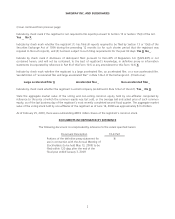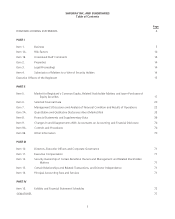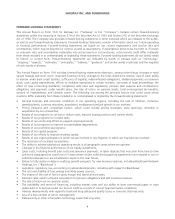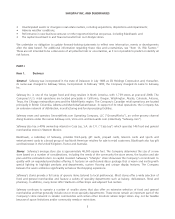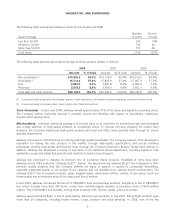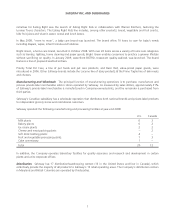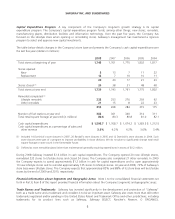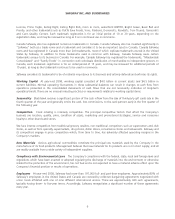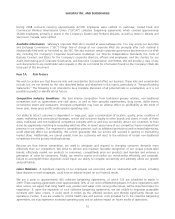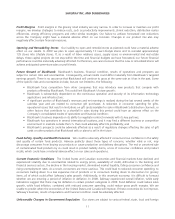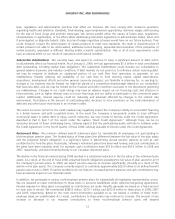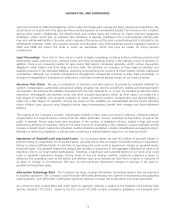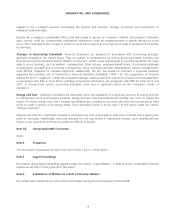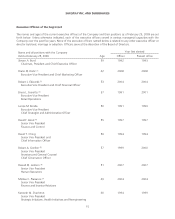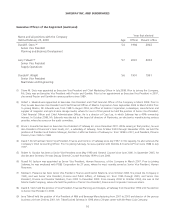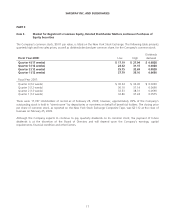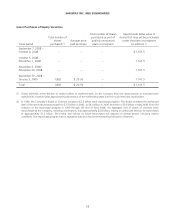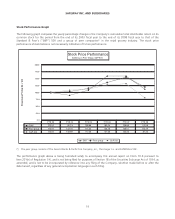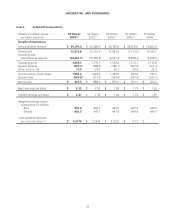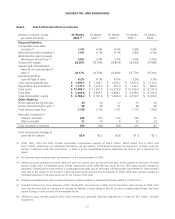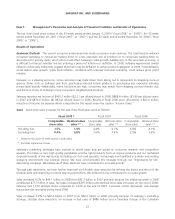Safeway 2008 Annual Report Download - page 32
Download and view the complete annual report
Please find page 32 of the 2008 Safeway annual report below. You can navigate through the pages in the report by either clicking on the pages listed below, or by using the keyword search tool below to find specific information within the annual report.SAFEWAY INC. AND SUBSIDIARIES
laws, regulations and administrative practices that affect our business. We must comply with numerous provisions
regulating health and sanitation standards, food labeling, equal employment opportunity, minimum wages and licensing
for the sale of food, drugs and alcoholic beverages. We cannot predict either the nature of future laws, regulations,
interpretations or applications, or the effect either additional government regulations or administrative orders, when and
if promulgated, or disparate federal, state, local and foreign regulatory schemes would have on our future business. They
could, however, require the reformulation of certain products to meet new standards, the recall or discontinuance of
certain products not able to be reformulated, additional record keeping, expanded documentation of the properties of
certain products, expanded or different labeling and/or scientific substantiation. Any or all of such requirements could
have an adverse effect on our results of operations and financial condition.
Substantial Indebtedness We currently have, and expect to continue to have, a significant amount of debt, which
could adversely affect our financial health. As of January 3, 2009, we had approximately $5.5 billion in total consolidated
debt outstanding, including capital lease obligations. This substantial indebtedness could increase our vulnerability to
general adverse economic and industry conditions. If debt markets do not permit us to refinance certain maturing debt:
we may be required to dedicate an unplanned portion of our cash flow from operations to payments on our
indebtedness, thereby reducing the availability of our cash flow to fund working capital, capital expenditures,
acquisitions, development efforts and other general corporate purposes; our flexibility in planning for, or reacting to,
changes in our business may be limited; we might be placed at a competitive disadvantage relative to our competitors
that have less debt; and we may be limited by the financial and other restrictive covenants in the documents governing
our indebtedness. Changes in our credit ratings may have an adverse impact on our financing costs and structure in
future periods, such as higher interest costs on future financings and our ability to participate in the commercial paper
market. Additionally, interest expense could be materially and adversely affected by changes in the interest rate
environment, fluctuations in the amount of outstanding debt, decisions to incur premiums on the early redemption of
debt and any other factor that results in an increase in debt.
The recent economic turmoil in the credit markets may negatively impact the Company’s ability to access debt financing
in a timely manner and with acceptable terms. In the event the Company is temporarily unable to issue sufficient
commercial paper or public debt to repay current maturities, we may choose to borrow under the Credit Agreement,
described in Part II, Item 7 of this report under the caption “Bank Credit Agreement.” Although there can be no
assurance because of these challenging times, Safeway expects that the participating banks will loan to Safeway under
the Credit Agreement. In the fourth quarter of fiscal 2008, Safeway was able to borrow under the Credit Agreement.
Retirement Plans We maintain defined benefit retirement plans for substantially all employees not participating in
multi-employer pension plans. The funded status of these plans (the difference between the fair value of the plan assets
and the projected benefit obligation) is a significant factor in determining annual pension expense as well as cash
contributions to fund the plans. Historically, Safeway’s retirement plans have been well funded, and cash contributions to
the plans have been relatively small. For example, cash contributions were $33.8 million and $33.0 million in 2008 and
2007, respectively, and were limited primarily to our Canadian retirement plans.
The decline in the financial markets during 2008 resulted in a substantial reduction in the fair value of the retirement plan
assets. As a result, at the end of fiscal 2008, projected benefit obligations exceeded the fair value of plan assets for all of
the Company’s pension plans. In 2009, we expect pension expense to increase significantly, primarily as a result of the
decline in the plan assets. The Company currently expects to contribute approximately $25.9 million to its defined benefit
pension plan trusts in 2009. If market conditions do not improve, increased pension expense and cash contributions may
have an adverse impact on our financial results.
In addition, we participate in various multi-employer pension plans for substantially all employees represented by unions.
We are required to make contributions to these plans in amounts established under collective bargaining agreements.
Pension expense for these plans is recognized as contributions are made. Benefits generally are based on a fixed amount
for each year of service. We contributed $286.9 million, $270.1 million and $253.8 million to these plans in 2008, 2007
and 2006, respectively. Based on the most recent information available to us, we believe a number of these multi-
employer plans are underfunded. As a result, contributions to these plans may continue to increase. The amount of any
increase or decrease in our required contributions to these multi-employer pension plans will depend
12


